The Great One: Pontiac’s 1968–72 Pontiac GTO lives up to its nickname
It’s no stretch to call Pontiac’s GTO the single most important car of the muscle car era. Yes, there are varying opinions as to when and how the American muscle car really kicked off. But the fact remains that the standard formula of taking a mid-size car and stuffing a large engine under the hood started with the GTO. Launched in 1964, it first came as an option on the LeMans, increasing the engine size to 389 cubic inches for a stout 325-horsepower in base form, and 348 with Tri-Power (three 2bbl carbs).
The GTO’s performance and sales success put everyone on notice, including Pontiac’s siblings within General Motors, and forced other brands to play catch up. But while the likes of Chevrolet and MOPAR focused on putting down huge raw power numbers, Pontiac struck a balance of offering excellent power with killer looks and more creature comforts than more entry-level manufacturers like Chevrolet, Dodge, and Ford.
1967 would be another watershed year with the old 389 being swapped out for Pontiac’s all-new 400 cubic inch engine. At least in the eyes of Poncho enthusiasts everywhere, the Pontiac 400 ranks among one of the all-time great engines and would be the basis for Pontiac’s famed “Ram Air” option. And with the introduction of an updated engine, it was time for Pontiac to update the GTO as a platform. While it had big shoes to fill, the second generation 1968-72 GTO was more than up to the task. Those were arguably the model’s best years but, being a muscle car with a wide range of available powertrains, performance options, convenience features and colors, the market for the second-gen Goat is a nuanced one, and values can range from barely above entry-level to well over half a million dollars.
1968

GM completely refreshed the A-Body platform on which the GTO rides for 1968. It was a welcome change, leaving behind the boxiness of the 1964-67 models in favor of the softer, curvier “Coke bottle” style popularized in the later part of the ’60s. Pontiac’s styling department also went to town on the GTO setting it far apart from the competition. The biggest innovation to the GTO’s look was the introduction of the revolutionary “Endura Bumper”, a GTO exclusive. In short, the bumper shook up the industry by eliminating the traditional chrome front bumper and instead replaced it with a painted, impact-resistant piece made of a rubberized material, which could be moulded to any shape and withstand minor impacts with minimal damage.
Such would be the, ahem, impact of the Endura Bumper that the concept across the industry, and the same basic idea remains on today’s cars. Complimenting the new nose, the GTO was also available with a set of hidden headlights. This optional piece covered the lights when they weren’t in use, creating the illusion of a wide uninterrupted grille.
Pontiac continued with the 400 engine as a standard offering (GM wouldn’t allow anything larger at the time), but the power numbers started to creep up. Pontiac rated the base 400 engine at a respectable 350 horsepower, and this engine accounted for the vast majority of GTOs. A no-cost optional 2bbl, low compression version was offered, but it is a very uncommon sight. After all, why would you go out to buy a performance car and then think, “Yes, I would love to have the economy engine”?
An optional Ram Air engine was available for 1968 but it didn’t make its way into very many cars. The Ram Air engine for 1968 was a High Output 400 with cold air induction and freer flowing exhaust, which bumped performance to 366 horsepower. Mid-term updates to the engine changed from a D-port exhaust to round port and a tad more aggressive cam. Horsepower ratings didn’t change, but this new “Ram Air II” engine was likely underrated (as were many Pontiac performance engines) and is somewhat of a rarity in 1968 Pontiacs these days.
1969

Following the 1968 debut of the newly designed A-Body, the 1969 GTO would see only subtle changes to the styling. Here are the easiest ways to tell the difference between a 1968 and 1969: The ’69 seats have headrests, the doors no longer have side vents, the side marker lights in the quarter panels no longer have the Pontiac arrowhead, and the tallights are set above the rear bumper instead of inside.
Under the hood, the base engine remained the same from the prior year, but the Ram Air engines rose in popularity. A 366-hp Ram Air III was the mid-range option, and a 370-hp Ram Air IV option debuted. On paper, it is only marginally more powerful than the Ram Air III, but that’s just on paper. The Ram Air IV received a more aggressive cam, stronger rotating assembly, and freer flowing heads, so rumors abound that these engines are far more powerful than rated.
Another big change to the GTO lineup for 1969 was the introduction of “The Judge” package. While the name sounds a little campy today, it was a clever play on pop culture of the time, referencing the popular comedy routine from Rowan & Martin’s Laugh-In TV show. Along with a groovy graphics package, loud colors and sporty Rally II wheels, The Judge came standard with the Ram Air III engine and could be optioned with the Ram Air IV.
1970
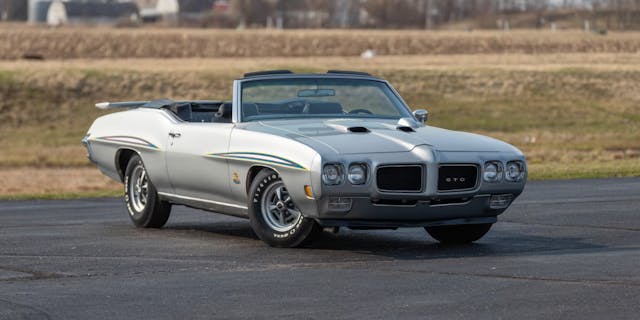
After two years of production, the GTO received a major facelift for 1970 with a redesigned front and rear bumper assembly, giving the car a more mature look than the edgier 1968-69 models. Other than the looks, the biggest update of note in 1970 was the introduction of Pontiac’s all-new 455 cid engine. By 1970, GM had lifted its engine size restriction in mid-size cars, opening the floodgates of big cube behemoths to compete with FoMoCo and MOPAR, who were not hampered by the same restrictions in their performance cars.
Other than the facelift and new engine, not much changed for the GTO from 1969 to 1970. The Judge package was again on offer, but was only available with the 400 cid Ram Air engines and would not get the 455 for another year. As a whole, the 1970 would see few fundamental changes aside from the facelift, but it is also a fan favorite amongst muscle car enthusiasts because of it.
1971
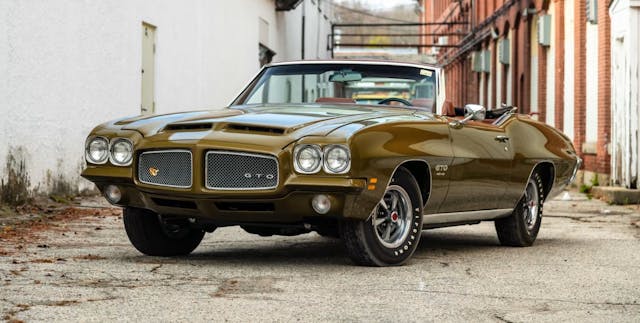
Another minor face lift arrived in 1971, with a more beak-like front nose and hood scoops relocated to the front. As this year was the beginning of the end for the golden age of American muscle, the Ram Air engines disappeared from the lineup, leaving the 455 H.O. engine as top dog. The H.O. borrowed heavily from the Ram Air engines, with round exhaust ports like the Ram Air IV, freer flowing exhaust and a spicier cam than the standard GTO 455. In simple terms, the 455 H.O. is about as close to a Ram Air type engine as it comes without just naming it one. The Judge nameplate stuck around one last year, available only with the 455 H.O.
Horsepower ratings also began to slip. For instance, the base 400 engine slipped from 350 horsepower in 1970 to 300 for 1971. It would only get worse from here.
1972
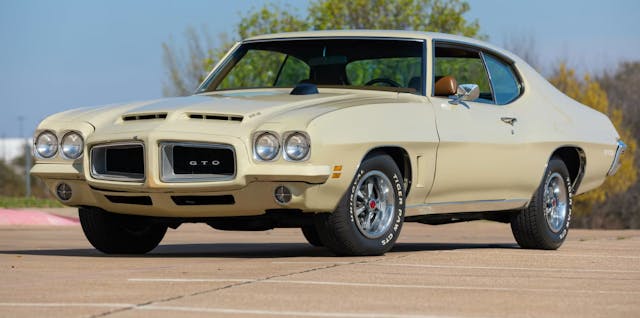
The final year in the series would see few substantial changes from 1971. Looks would remain nearly identical to the previous year, but car spotters will notice the set of faux fender vents behind the front wheels. The biggest change in the GTO lineup would be what was missing. First, The Judge package was not offered in 1972. Second, horsepower ratings took another nosedive thanks to tightening emissions regulations and the switch from the industry standard of gross horsepower rating (basically the potential horsepower of the engine) to a net rating (a more realistic figure for a fully dressed actually equipped in the car). The GTO also ceased to be its own separate model and went back as an option package for the LeMans. When the third generation GTO debuted for 1973, it stayed on as a LeMans option but performance-wise was a long way from its peak just a few years before.
Buying a second-generation GTO
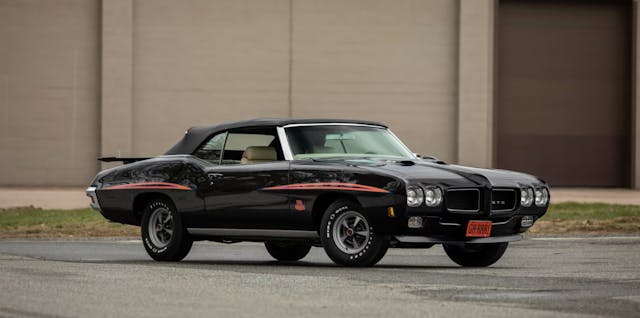
The market for a 1968-72 GTO is as nuanced as the yearly changes. As is the case with any classic muscle car, power, options, and rarity are the biggest factors when it comes to what buyers are willing to pay. While a clean, base 400-powered-GTO will run enthusiasts anywhere from $35,000 – $55,000 in this market, that’s just a jumping off point.
The most sought-after are Ram Air IV-powered Judges. But more specifically Judge convertibles. If there is a Holy Grail GTO it’s the 1969 Judge Convertible with the Ram Air IV. Only five were produced, making it one of the only muscle cars that can make a Hemi Cuda convertible look common.
Next up in terms of collectability is the 1970 Ram Air IV Judge Convertible, with an estimated 18 produced. The most recent high sale of one of these Judge Convertibles was $1.1 million for a 1970; however, a handful of recent sales in the spring of 2023 suggest that the market is hovering more in the range of $400,000 – $500,000.
A 1969-70 Judge is vastly more collectible than base GTOs equipped with the same drivetrain, while 1968 Ram Air IIs are rare as hens’ teeth, even if they don’t bring Ram Air Judge Convertible money. 1971-72 GTOs tend to be the bargain (comparatively), as the less refined looks and the lower horsepower can be a turnoff to buyers, but definitely shouldn’t be overlooked.
Speaking of buyers, it should come as no surprise that the overwhelming majority of interest for these cars comes from the Baby Boomers who knew and loved GTOs when they were new. Nearly half of the quotes Hagerty receives come from Boomers, with Gen-X coming in at 34 percent. From there it drops off like a stone. It should come as no surprise that Millennials and Gen-Z are the smallest piece. But this is likely due to a couple of factors, one being interest and the other being cost. Yes, it is a true statement that collectors tend to gravitate to cars they remember fondly as kids, but a solid GTO is not exactly an inexpensive purchase for a group that hasn’t had much time to accumulate the wealth and disposable income for expensive cars.
It’s worth noting though that while “kids” aren’t buying a GTO in big numbers, it has done little to curb the appeal. While the more valuable GTOs like Ram Air-equipped cars are more susceptible to swings in value, the overall GTO market has remained fairly steady, with only a bit of fluctuation in the past three years as the market has heated then cooled again.
That said, most of us don’t buy cars with the sole intention of making a buck (it’s nice when we do though). It’s all about how the car drives and makes us feel. And a clean second-generation GTO drives well and makes us feel great. With the looks, winning performance, and unmatched pedigree, it’s no wonder people call the GTO “the great one.”
***
Check out the Hagerty Media homepage so you don’t miss a single story, or better yet, bookmark it. To get our best stories delivered right to your inbox, subscribe to our newsletters.

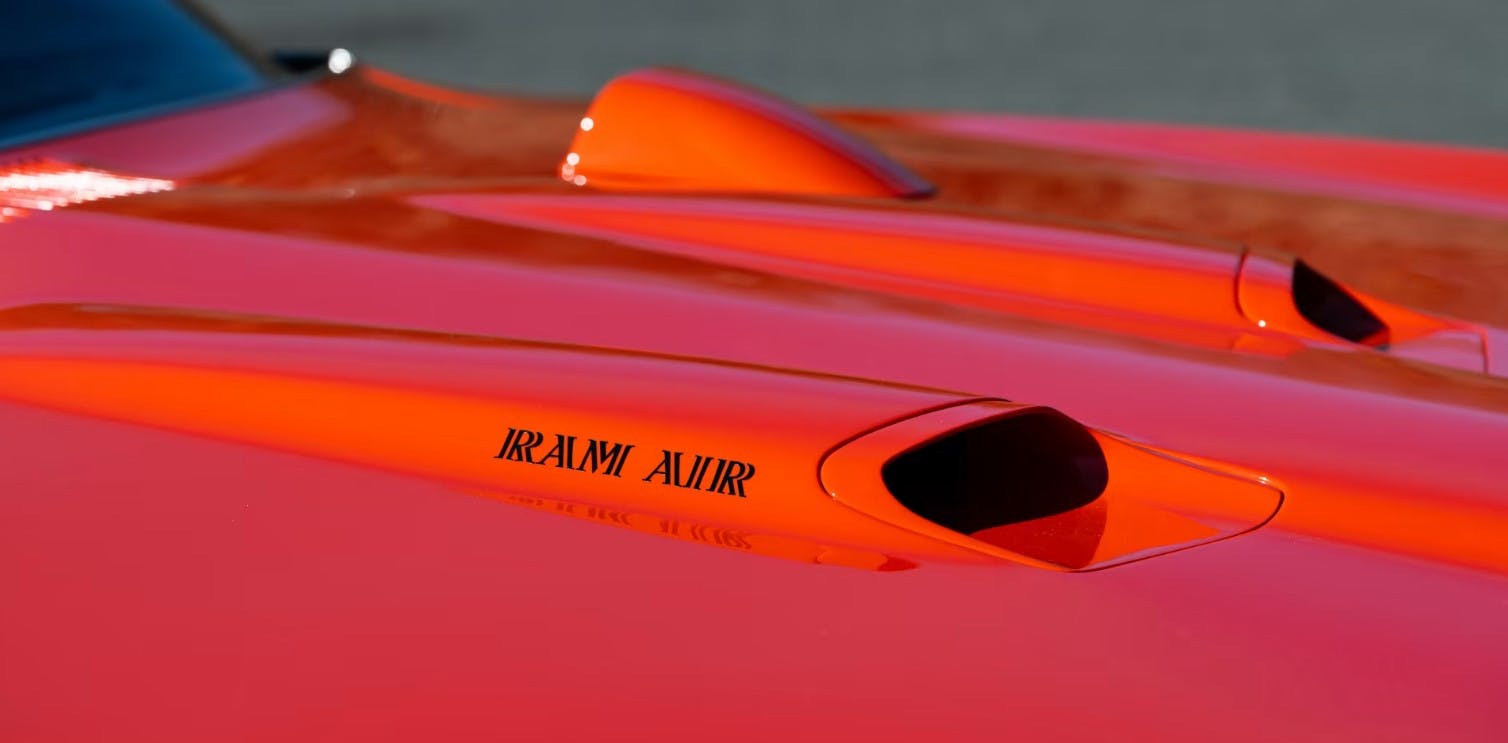


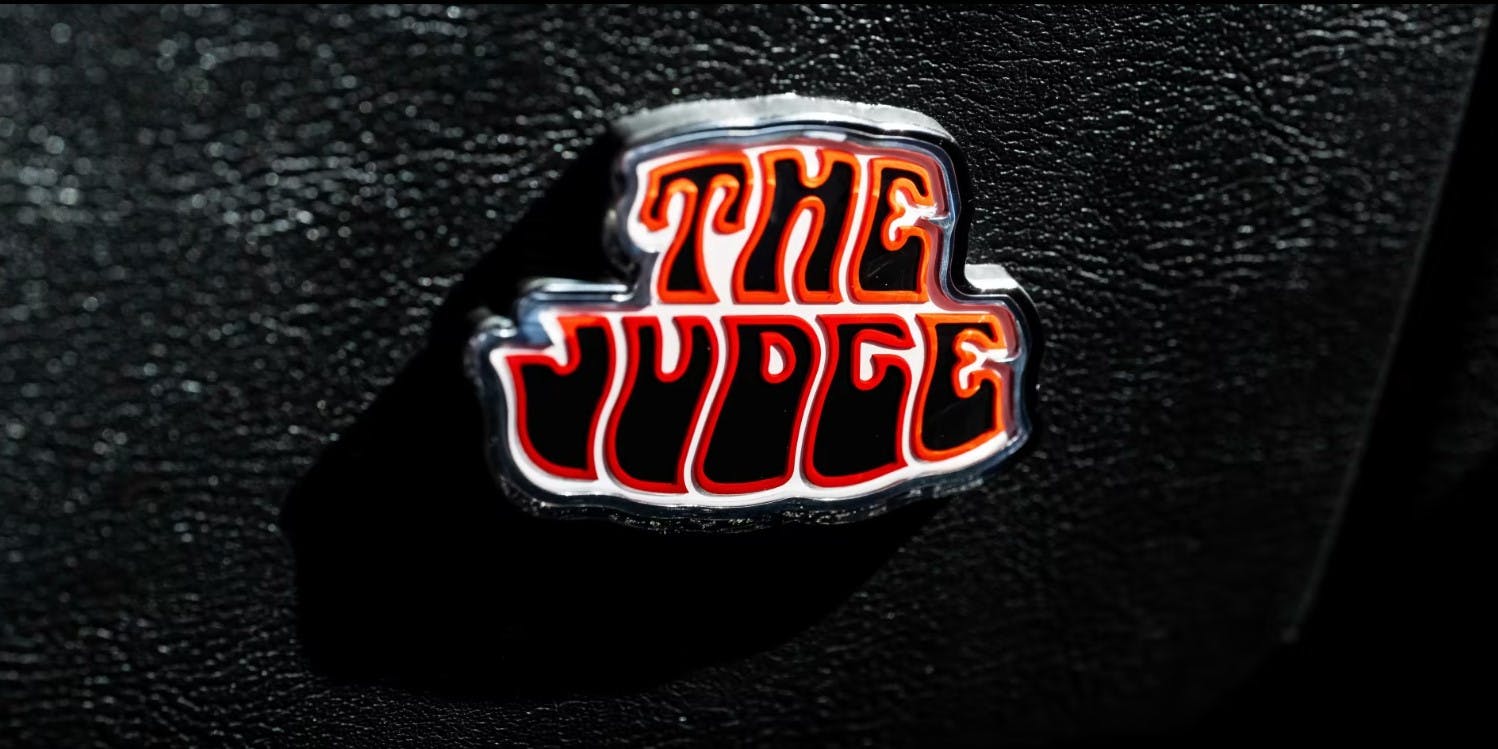

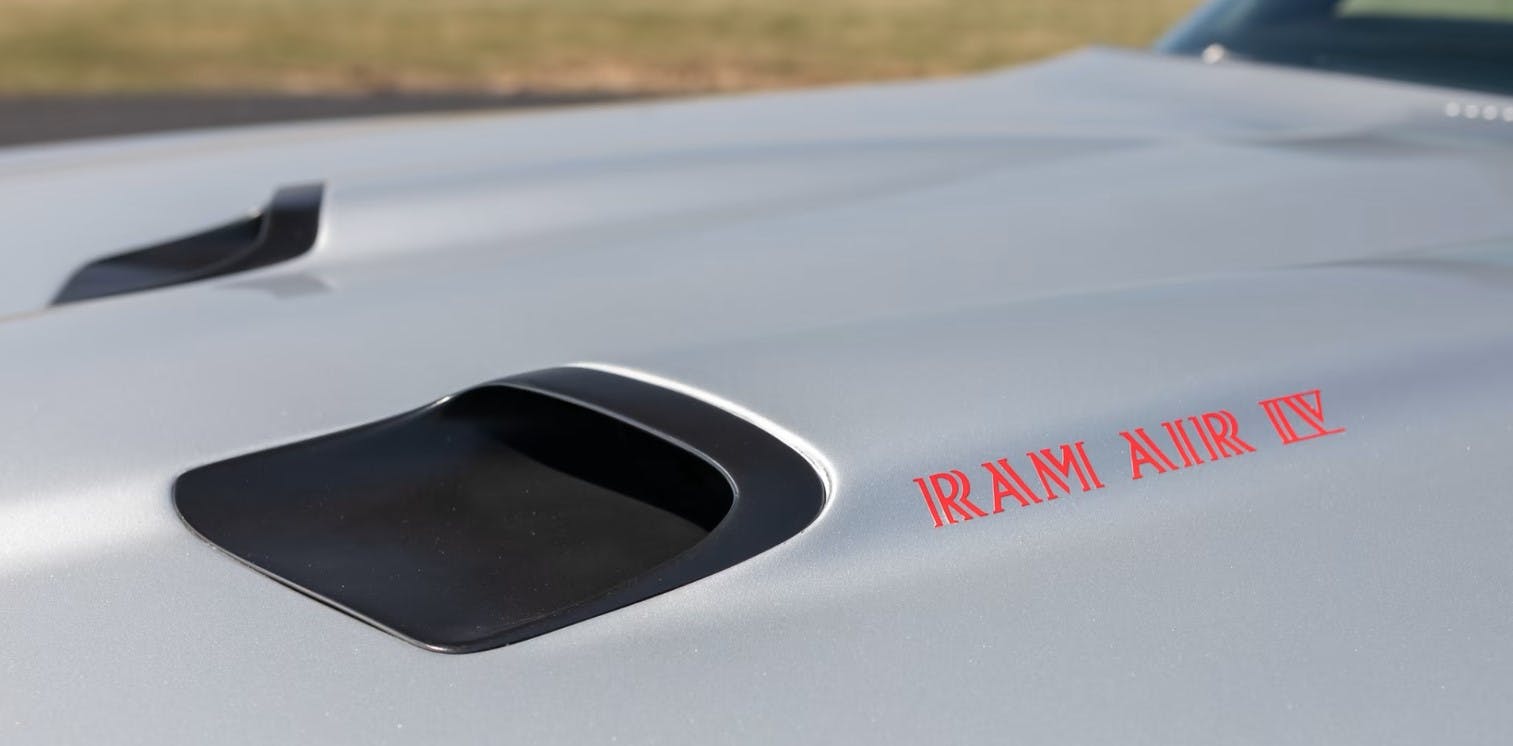


Hagerty has the data… prove to me that “generational interest” in vehicles doesn’t have more to do with the price bracket said vehicle belongs to for anything worth over $15000 rather than when a person happens to have been born.
That is to say… where you are at in your life income journey would appear to me to be a much better predictor of what you are into.
You have to cut off the 100K + cars as well, as that is just rich people playing and not your everytown nice car show type cars.
*look back at Hagerty’s data for 10 and 20 years ago (prices adjusted) I think this would hold true.
The “data” can prove or disprove anything you’d like it to, depending on how you assemble it and interpret certain factors – that’s been shown over and over again. And then, as with most everything, there are “exceptions to the rule”. While your viewpoint may or may not be correct in the overall picture, it’s certainly not an absolute. I know many people from a certain generation (including myself) who are very much “into” a specific genre of cars STRICTLY because of when we were born. And we’re certainly at a point in our “life income journey” (I LOVE your term, b-t-w 😃) where price is not the driver of our purchase decisions. We are unapologetic nostalgists, to be sure – but we like what we like because it delighted and inspired us as youths, and obviously nothing (regardless of price) from any other genre has managed to replace that.
I personally dabbled in several other groupings of cars and trucks (in multiple price ranges) throughout my journey, and always, ALWAYS returned to my roots, strictly BECAUSE of when I happened to be born.
Am I saying that is 100% true with everyone? Absolutely not. But as hyperV6 says below, there are MANY reasons for people (even if you exclude the $100K+ folks) to buy what they buy. Your point is surely one of them. But I personally doubt that scrutinizing “the data” would prove much, if anything at all.
Bravo. I’m a GTO guy, have been since the late 1960s, when my uncle drove us to our private schools, he HS, me 6 years younger. I have a TorRed 40th Anniversary ’04 with an aftermarket 7.0L LS motor and Tremec 6spd crunch box that went into winter storage today. I’m killing that car cuz I love driving it so much I tend to avoid fixing things other than routine maintenance. I could drive pretty much any but the rarest GTO, I’m a 64yoa disabled veteran with a decades long career, but I respect the cars that should be preserved and don’t have time for “projects”. That said, if I could find a ’73 GTO, I have a complete but rear-ended ’77 CanAm and a couple 6.0 & 6.2 LS motors… Oh, the possibilities.
But I have a GTO because that’s what I want. If I were poorer, I’d do without to have a GTO to drive. Oh, the things I do for love!
The 69 to 71 era is proven the most magical and will be eternal and will only get stronger. Just look at the big 3 car makers today. Even the big 3 realizes they haven’t had a better idea in almost 60 years, just look at the new Challengers, Camaros and Mustangs.
There are many reasons people buy what they buy.
These cars were before my time but I still love them.
I came into these in the 80’s when one could buy them cheap. Those days are over.
Each gen has what they like or what they can afford. That is what plays a roll. Today most kids have little love of cars as most can’t afford anything fun or cool.
I grew up with these, but I always liked the ’64-67 models much, much more! In ’68 The whole A-body line just got too FAT for me. They do look good as convertibles, but still too fat. Give me a ’66 Tempest, Lemans first. Love those cat’s eye taillights!!! Also loved the ’66 GTO.
Sorry, the 1966 GTO convertible is the best car design of all time. And who doesn’t want a 389 with 3 deuces ?
What does posting comments to quickly really mean?
It means the system can’t handle us I think. I get it a few times myself. Waiting 5 minutes doesn’t help either. It’s silly and random.
I believe you’re correct. I get that message sometimes when I haven’t posted anything for days. It’s just poorly worded. It’s not that YOU are posting too quickly – it means that too many people are posting at nearly the same time. As you said – the system can’t handle the load at the moment.
I think it means you have been logged off, maybe a long time since your last post. I have relogged on and it worked even though I was already logged on.
The tail end of this generation GTO looked good but is the beginning of disappointment for me.
Boxiness?!? Who on earth would ever look at my ‘65 LeMans (I know, but I still can have an opinion about that body style since it’s the SAME!) and think boxy?! Those clean lines have wowed many, including me who when my husband bought it, thought I wouldn’t like the styling and would only drive it till our ‘50 Ford was finished. It is now my car, with a vanity plate ( LEMOMS) that clearly declares her body styling and other attributes (love how she corners!) have thoroughly won my heart! I won’t trash the “curvy” lines of the newer models but those were the reason I thought I didn’t want our Pontiac. I equated that era with the newer body style and my description for them was bulging fendered, fat looking cars (sorry, I calls ‘em like see them). Praise the later ‘60’s muscle cars all you want, that’s fine with me, it takes all kinds but declaring the fine, clean lines of the earlier A-body cars is unfair and puts the rest of your opinion into question.
Always liked the ’65 for the stacked headlights and really clean taillight treatment. The squared off roof is also quite attractive. But for me, the ’66 hardtop is the thing. My ’04 was, in the day, reviled as appearing a “fat Cavalier”. I think it has held up well, but the ’66 is GTO at the peak. My opinion only.
Never understood why they didn’t keep the same front end from ‘70 on the ‘71-‘72 models. Pontiac did with the Firebird thru ‘73.
I love the old chrome-bumper goats.